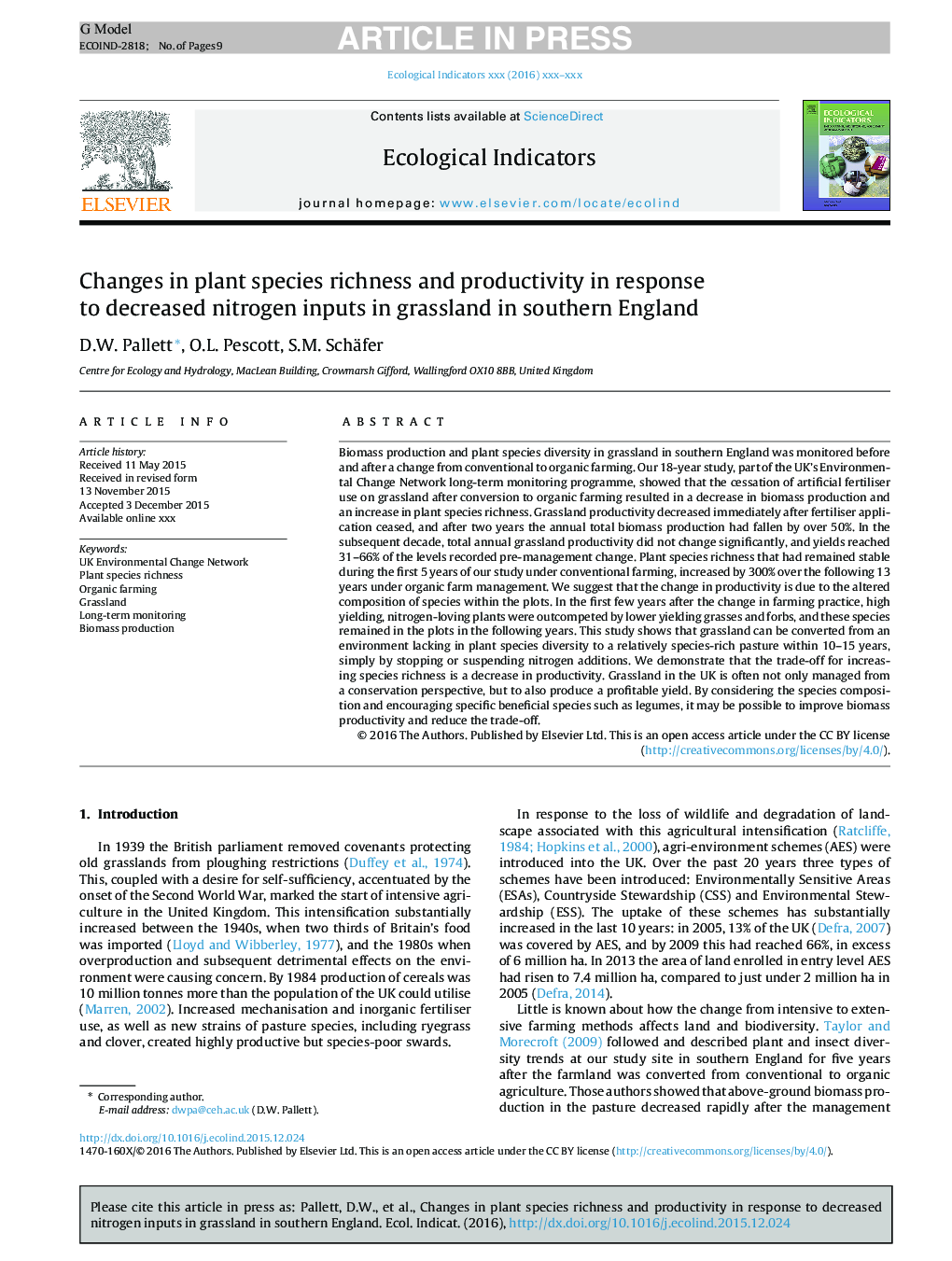| کد مقاله | کد نشریه | سال انتشار | مقاله انگلیسی | نسخه تمام متن |
|---|---|---|---|---|
| 6293169 | 1617134 | 2016 | 9 صفحه PDF | دانلود رایگان |
عنوان انگلیسی مقاله ISI
Changes in plant species richness and productivity in response to decreased nitrogen inputs in grassland in southern England
ترجمه فارسی عنوان
تغییرات در غنای گونه گیاهی و بهره وری در پاسخ به کاهش ورودی نیتروژن در چمنزارهای جنوب انگلستان
دانلود مقاله + سفارش ترجمه
دانلود مقاله ISI انگلیسی
رایگان برای ایرانیان
کلمات کلیدی
شبکه تغییر محیط زیست انگلستان غنای گونه گیاهی، کشاورزی ارگانیک، چمنزار نظارت بلند مدت، تولید زیست توده،
ترجمه چکیده
تولید زیست توده و تنوع گونه های گیاهی در چمنزارهای جنوب انگلیس قبل و بعد از تغییرات از کشاورزی متعارف به کشاورزی ارزیابی شد. مطالعه 18 ساله ما، بخشی از برنامه نظارت بر طول عمر زیست محیطی بریتانیا در بریتانیا، نشان داد که توقف استفاده از کود های مصنوعی در مزرعه پس از تبدیل به ارگانیک باعث کاهش تولید زیست توده و افزایش غنای گونه های گیاهی شد. بهره وری علف های هرز بلافاصله پس از پایان کود کاهش یافت و پس از دو سال تولید بیش از 50٪ کل تولید زیست توده کاهش یافت. در دهه های بعد، بهره وری علف های هرز سالانه به طور قابل توجهی تغییر نیافت و تولید به میزان 31-66 درصد از میزان تغییرات پیش مدیریتی ثبت شد. غنای گونه گیاهی که طی 5 سال اول مطالعه ما در کشاورزی معمولی باقی مانده بود، طی 13 سال بعد، تحت مدیریت مزرعه ارگانیک، 300٪ افزایش یافت. ما پیشنهاد می کنیم که تغییر در بهره وری ناشی از ترکیب تغییر یافته گونه درون توطئه ها است. در چند سال اول پس از تغییر در فعالیت های کشاورزی، گیاهان پرطرفدار، نیتروژن دوستانه با گیاهان دارویی و فلفل زراعی کم توانایی داشتند و این گونه در سال های بعد باقی می ماند. این تحقیق نشان می دهد که طی طی 10 تا 15 سال، می تواند از محیطی که فاقد تنوع گونه ای گیاهی است به یک مرتع پرورش یافته نسبتا گونه ای تبدیل شود، به راحتی با توقف یا تعلیق افزودن نیتروژن، تبدیل می شود. ما نشان می دهیم که همکاری برای افزایش غنای گونه ها، کاهش بهره وری است. گندم در انگلستان اغلب نه تنها از منظر حفاظت مدیریت می شود، بلکه تولید سودآور نیز می شود. با در نظر گرفتن ترکیب گونه و تشویق گونه های خاصی از جمله بومی، ممکن است بهبود بهره وری زیست توده را کاهش داده و تجارت را کاهش دهیم.
موضوعات مرتبط
علوم زیستی و بیوفناوری
علوم کشاورزی و بیولوژیک
بوم شناسی، تکامل، رفتار و سامانه شناسی
چکیده انگلیسی
Biomass production and plant species diversity in grassland in southern England was monitored before and after a change from conventional to organic farming. Our 18-year study, part of the UK's Environmental Change Network long-term monitoring programme, showed that the cessation of artificial fertiliser use on grassland after conversion to organic farming resulted in a decrease in biomass production and an increase in plant species richness. Grassland productivity decreased immediately after fertiliser application ceased, and after two years the annual total biomass production had fallen by over 50%. In the subsequent decade, total annual grassland productivity did not change significantly, and yields reached 31-66% of the levels recorded pre-management change. Plant species richness that had remained stable during the first 5 years of our study under conventional farming, increased by 300% over the following 13 years under organic farm management. We suggest that the change in productivity is due to the altered composition of species within the plots. In the first few years after the change in farming practice, high yielding, nitrogen-loving plants were outcompeted by lower yielding grasses and forbs, and these species remained in the plots in the following years. This study shows that grassland can be converted from an environment lacking in plant species diversity to a relatively species-rich pasture within 10-15 years, simply by stopping or suspending nitrogen additions. We demonstrate that the trade-off for increasing species richness is a decrease in productivity. Grassland in the UK is often not only managed from a conservation perspective, but to also produce a profitable yield. By considering the species composition and encouraging specific beneficial species such as legumes, it may be possible to improve biomass productivity and reduce the trade-off.
ناشر
Database: Elsevier - ScienceDirect (ساینس دایرکت)
Journal: Ecological Indicators - Volume 68, September 2016, Pages 73-81
Journal: Ecological Indicators - Volume 68, September 2016, Pages 73-81
نویسندگان
D.W. Pallett, O.L. Pescott, S.M. Schäfer,
